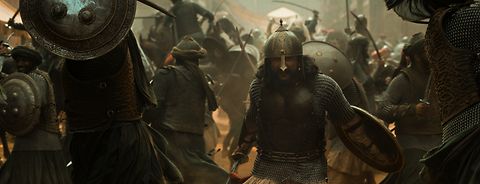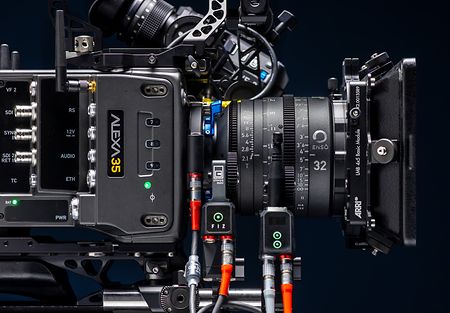Based on the life of Sambhaji Maharaj, who ruled India’s Maratha Empire in the late 17th century, “Chhaava” is a visually opulent Hindi-language historical action film produced by Dinesh Vijan’s Maddock Films and directed by Laxman Utekar. Hugely popular with domestic audiences, “Chhaava” is the most successful Indian movie of the year. Cinematographer Saurabh Goswami ISC spoke to ARRI about how the ALEXA 35 helped him capture beautiful images in varied lighting conditions over the course of 96 challenging shoot days spent primarily on location in Western India.

(Left to right) Sudarshan Limbole (2nd camera operator), Saurabh Goswami ISC (cinematographer), and Babloo (Steadicam operator).
How did you collaborate with the director to bring his vision to life?
The director Laxman Utekar, who is also a renowned DP himself, had a clear vision of creating an immersive and historically rooted world, and our collaboration was built on a shared understanding of the Maratha Empire’s culture, architecture, and lifestyle. We dedicated five or six months of prep time to researching historical references, artwork, and architecture to shape a visual language that felt true to the 17th century.

Exceptionally rich color rendition and shadow detail are evident in the scene showing Sambhaji’s coronation.
Creative choices around lighting, composition, and camera movement were made with the aim of reflecting the era’s mood and narrative demands. We focused on how people of that time experienced their environment through natural light sources like the sun, moon, and fire, and we built our visual framework around them.
What else contributed to the visual style of the film?
The visual style of “Chhaava” is rooted in authenticity, texture, and atmosphere, with a deliberate use of rich colors to evoke the 17th-century Maratha Empire. Together with the production designers Subrata Chakraborty and Amit Ray, and costume designer Sheetal Sharma, I drew inspiration from classical paintings and traditional Indian art, embracing a palette that reflected natural materials like stone, wood, and fabric, as well as the warm glow of firelight and the cool tint of moonlight.
Each scene was crafted to reflect the feel and environment of the moment, whether it was the golden warmth of sunlit battlefields or the cool, bluish-gray hues of night sequences. Our goal was to capture not just the historical setting, but also the emotional temperature of each moment.

The ALEXA 35 sensor balancing low light, beautiful skin tones, and small flame sources in a scene set at Soyrabai’s court.
What cameras and lenses did you choose, and how did they impact the overall look?
We shot with the ARRI ALEXA 35 camera and Cooke S4/i prime lenses, and that pairing really helped define the visual feel of the film. The ALEXA 35’s Super 35 sensor gave us incredible flexibility and the dynamic range is outstanding. It handled tough lighting situations beautifully, whether we were shooting under the harsh summer sun or working with firelight at night. We could hold detail in both the highlights and shadows, which was crucial in a film like this.

Action and VFX combine in the scene where Sambhaji Maharaj fights a lion, with the dust creating strong shafts of light.
What really stood out was ARRI’s REVEAL Color Science. The colors felt rich and true straight out of the camera; skin tones, firelight, and natural elements all had a beautiful, organic look. It gave us a strong starting point in post without needing to push too hard in the grade. All in all, our camera and lens choice gave us something that felt textured, cinematic, and grounded—exactly what we needed to bring this world to life.
What were some of the main technical challenges you faced during the shoot?
Shooting in the intense summer heat of Maharashtra, often in temperatures soaring above 40-45°C, was one of our biggest challenges. We were outdoors most of the time, dealing with dust, humidity, and constantly changing natural light. Despite all that, the ALEXA 35 held up incredibly well. It didn’t overheat or fail, even in the harshest conditions, which gave us a lot of confidence on set.
We also shot in the rain on a few days, so the camera had to be fully covered for protection. Even then, the internal fan cooling system of the camera helped regulate the temperature inside the rain cover and kept it running smoothly throughout.
Were there any scenes that were particularly rewarding to shoot, for you?
Some of the most challenging and rewarding sequences were the large-scale fight scenes, set both during the day and at night. Capturing the chaos and intensity of battle, while maintaining clarity and mood, required careful coordination between camera, light, and movement. The war sequence at Sangameshwar, where Sambhaji gets captured, was particularly interesting. According to history, the Mughal army attacked Sangameshwar late at night. The war started inside the palace, where the courtyard was packed with Mughal and Maratha soldiers, and slowly moved outdoors as dawn broke. This sequence was challenging in terms of the light transition from night to dawn and then to harsh sun.

The Sangameshwar war sequence started at night in a courtyard and then involved a challenging transition to a dawn exterior.
For the night fight scenes, our lighting approach was grounded in realism. Most of the light sources were actual fire elements, such as torches, fire pits, and burning props, supplemented with lights on flicker effects for subtle fill. This created a natural flicker and warmth that suited the historical period. The ALEXA 35’s low-light performance meant it held shadow details beautifully without introducing noise, and the lenses were essential in preserving depth and atmosphere.

Varied lighting conditions and dynamic camerawork add to the drama of a montage sequence showing nine years of war.
The daytime battles demanded a lot from the camera in terms of handling harsh sunlight, dust, and fast-paced action. The ALEXA 35’s dynamic range allowed us to retain detail even under direct, unforgiving light, which was especially important for wide shots with bright skies and shaded foregrounds. We used the default ARRI Texture, which gave us a great balance of sharpness and softness, retaining a natural look while still feeling cinematic.
What role did camera movement play in telling the story?
Camera movement played a vital role in making “Chhaava” feel immersive and emotionally grounded. Since the story is based on the life and legacy of a warrior, we wanted the visuals to feel dynamic, close to the characters, and emotionally responsive. The camera movement wasn’t just functional, it was part of the storytelling language.
We used a mix of handheld and stabilized movement to match the rhythm of each scene. In the battle sequences, the camera was often handheld—intentionally raw and reactive to place the viewer amidst the chaos and intensity. That slight unpredictability added an energetic feel to the action, enhancing the realism of combat. For smoother transitions and more poetic or emotional beats, we used systems like the Magnum Dolly, ARRI TRINITY, and NB Stabilizer Rock-a-bye, which allowed us to execute fluid, cinematic shots without losing mobility, especially across uneven outdoor terrain.

Cinematographer Saurabh Goswami operating the ALEXA 35 in an aerial body rig while 1st AC Sunny Devkar keeps an eye on focus.
The compact and lightweight nature of the ALEXA 35 made it easy to move between styles quickly and adapt to the demands of each scene, both creatively and practically. I also completely rely on the ALEXA 35’s ergonomic viewfinder. I love operating with the viewfinder if I’m handheld or on a dolly, and even if the camera is on the ARRI TRINITY or a jib arm, I’ll keep the viewfinder handy to monitor the image.

